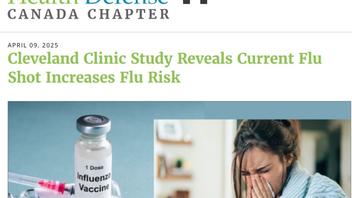
Does a draft paper by scientists at The Cleveland Clinic "reveal" that the 2024/2025 flu shot increased the risk of flu, as social media posts claim? No, that's not true: This study's finding that vaccination was "associated with" a higher risk isn't the same as showing the vaccine is what caused increased risk. The authors of the study found that vaccinated health care workers had a 27% higher incidence of flu than those who were not vaccinated.The researchers said their paper did not identify what factors caused the higher infection rate, only that the shot was relatively ineffective.
The claim appeared in an April 9, 2025 post (archived here) published by Children's Health Defense Canada Chapter under the title "Cleveland Clinic Study Reveals Current Flu Shot Increases Flu Risk". It opened:
A landmark study from the Cleveland Clinic has found that the 2024-2025 flu vaccine not only failed to protect adults, but actually INCREASED their risk of contracting the flu.
This is what the post looked like on Facebook at the time of writing:
(Source: Facebook screenshot taken on Thu Apr 10 21:55:08 2025 UTC)
The headline on the Children's Health Defense website declares the increased risk of flu was caused by the shot, but that is not what the Cleveland Clinic Study established.
The study, (archived here) which has yet to be formally reviewed by outside professional peers, was posted April 4, 2025 to MedRxiv.org a server where early drafts of scientific papers are posted to speed the sharing of new findings among scientists. It's formal conclusion:
This study found that influenza vaccination of working-aged adults was associated with a higher risk of influenza during the 2024-2025 respiratory viral season, suggesting that the vaccine has not been effective in preventing influenza this season.
But, the study did not identify a cause for the difference, said lead author Prof. Nabin Shrestha, MD, of the Lerner College of Medicine. "There is a distinction between what a study finds and the conclusions one draws from those findings," Shrestha wrote in an April 11, 2025 e-mail to Lead Stories:
Although the results showed an increased risk of influenza among those who were vaccinated, we understood that the finding of an increased risk could have been from an unrecognized factor.
For this reason when we drafted our study's conclusion, we did not conclude that the vaccine increases the risk of infection.
Asked to list possible factors, Shrestha declined to speculate.
In scientific studies, association shows a statistical connection between variables, but not necessarily that one causes the other. An example from a data science textbook: Tutoring reduces test scores, since tutored students' test scores are lower than students who don't use tutors. That conclusion gets the association backward if students struggling with school are more likely to seek tutoring.
The Cleveland Clinic study collected data on about 40,000 adult health care workers. In its draft form, the paper reports vaccinated health care workers were significantly more likely to catch the flu than the non-vaccinated. The authors' conclusion was that the shot was not very effective against flu. What they did not conclude was what factor specific to the vaccinated portion of the 40,000 made them more likely to get infected.
This is similar to what happened during the COVID pandemic. No vaccine is 100% effective. So, as the number of vaccinated persons increased, most new cases of COVID were in vaccinated people, a fact vaccine skeptics used as proof the vaccines were dangerous.
But in a 2023 fact check of similar claims about a Cleveland Clinic study of COVID vaccine effectiveness, a medical researcher noted that one explanation for higher infection rates among the vaccinated is that people who don't bother to get vaccinated probably also don't bother to get tested for infection, which skews the data.
The Cleveland Clinic flu vaccine study looked back at medical records of more than 40,000 health care workers, which means the study includes no children and few elderly persons. The group differs from the population at large in that health care workers are considered at high risk of contracting influenza (archived here), sometimes estimated to be three times more likely to get the flu than adults in the general population.
The spokesperson for the Cleveland Clinic, wrote in an April 10, 2025 e-mail to Lead Stories that Children's Health Defense incorrectly concluded the flu shot increases flu risk:
The results do not suggest that vaccination increases the risk of flu.
Instead, the study implies that the effectiveness of this season's vaccine in preventing influenza may have been limited in relatively healthy health care workers.
Cleveland Clinic's spokesperson noted the small number of infections among the vaccinated participants in the study:
... of the 43,000 individuals who received the vaccine, only a small number [1,079 (2%)] contracted influenza during the study period.
Other scientists have looked at the effectiveness of the 2024/2025 flu vaccine. The United States Centers for Disease Control and Prevention, in its February, 2025 report on the 2024/2025 flu shot, (archived here) found it generally effective and made no statement that it was increasing the risk that a person would contract the flu: "Vaccination with the 2024-2025 influenza vaccine reduced the risk for influenza-associated outpatient visits and hospitalization."
Over the past decade, effectiveness has ranged from a low of 19% to a high of 60%, (archived here) according to flu.org, a group that advocates for flu vaccination. The variability is attributed to the difficulty of predicting, six to nine months in advance, which flu strains are going to be dominant and should be included in the vaccine.
Additional fact checks about influenza can be found here.















